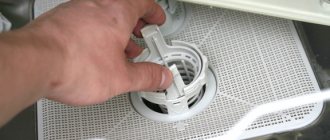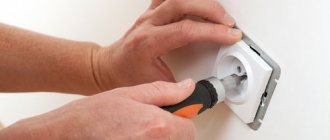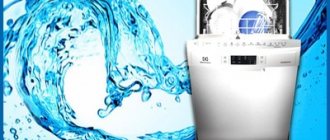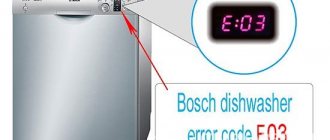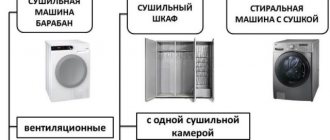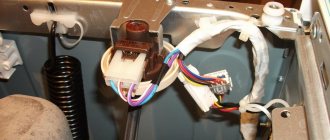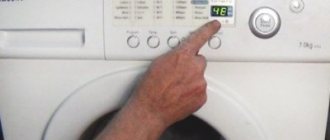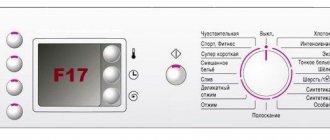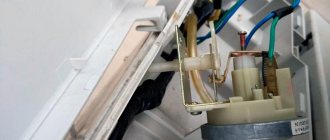Calculate cost Reviews Geography Contacts
Electrolux service center No. 1 in Moscow Post-warranty service and repair of Electrolux with home visits, seven days a week from 9:00 to 22:00
8 Call back
If the ELECTROLUX dishwasher does not turn on and does not work, either a lack of voltage in the network or a burnt-out control unit may be to blame. In the first case, it is enough to wait until electricity is supplied to your home, in the second, you will have to spend a lot of money on replacing the unit.
The main causes of malfunctions include:
- lack of electricity;
- broken socket or cord;
- broken surge protector;
- problems with the control unit;
- damage to the wiring in the body of the ELECTROLUX dishwasher;
- faulty heating element.
It is not always worth calling a specialist. First, you need to make sure that the help of a specialist is generally necessary.
What to do if the dishwasher won't turn on?
First of all, you need to decide what exactly is not working. Is the backlight working? Does the machine respond to button presses? If the equipment shows no signs of life, you need to check:
- is the machine connected to the electrical network;
- is there electricity;
- Is the socket working?
Plug your ELECTROLUX dishwasher into a different outlet and try to start it. Is the problem resolved? Call an electrician and have the outlet repaired.
The next “node” in line is a cord or surge protector. Both can be replaced without problems. The main thing is to make sure that this is the case. This will require a voltmeter and minimal electrical experience. You can also go the experimental route: buy a spare power cord or filter and connect it to the ELECTROLUX dishwasher. They are inexpensive and in certain cases help solve the problem without contacting a specialist.
If replacing the cord does not help, the problem may be in the control unit, heating element or wiring inside the case. The unit may burn out due to voltage surges and other reasons. Remember, did the machine work normally in recent weeks, did it give an error? Maybe the equipment didn’t wash the dishes clean before the breakdown? By remembering what preceded the breakdown, you can determine its cause. And then call a specialist.
How does a dishwasher work?
To repair a dishwasher, you need to understand the processes that occur in it. This is the only way to determine the possible causes of the breakdown and eliminate them as soon as possible.
Let us describe the general principle of operation of a dishwasher. The operating algorithm is usually the same for all manufacturers, although some changes may occur. Next, we will describe the most time-consuming process - washing dirty dishes with time to “acidify” the remaining food.
- After loading the dishes, the door closes. This is recorded by a special sensor. If the lock is not closed, the dishwasher will not start.
- The user selects the dishwasher operating mode and presses the “Start” button.
Rinse water is supplied from all sides
- The water intake valve opens and it is pumped into a special tank. Along the way, it is mixed with softening salts and detergent. The water level is controlled by appropriate sensors.
- The tank contains heating elements - heating elements. They heat the water to the required temperature (depending on the selected mode). The degree of heating is controlled by a temperature sensor. The process continues only if the sensor is triggered.
- Heated water is supplied by a circulation pump to nozzles located on the side surfaces and sprayed in small portions. This is the "soak" mode.
- The liquid draining from the dishes is collected in a tray, passes through filters, and is again supplied to the nozzles.
- At the end of the time allotted for this mode (controlled by the processor), the rinsing mode is activated.
- In this mode, water is supplied from the main sprinkler, which is located under the basket with dishes. Powerful jets of water directed in different directions wash away any remaining dirt.
- The process goes on cyclically - the water is filtered, more detergent is added to it, and it again ends up in the sprinkler. This is how the final removal of contaminants occurs. The number of cycles depends on the selected program.
- After this mode ends (controlled by the processor), a command is given to drain the dirty water. The pump pumps it out of the reservoir.
- A small portion of water is pumped in to rinse the tank and removed again.
- Water is collected for rinsing. It is fed into a sprayer, which sprays it in different directions, washing the dishes from all sides. The rinsing process can be repeated several times.
- Waste water from the reservoir is pumped into the sewer system.
- Drying mode is activated. It all depends on the type of dishwasher. If there is a drying mode, heating elements are turned on to heat the air. Heated air is forced into the chamber using a fan. If there is no such mode, the dishwasher simply turns off - the dishes dry by convection.
Water is supplied from the nozzles under pressure
As you can see, a large number of sensors are involved in the process. All of them can fail and cause a breakdown. Filters, nozzles, and sprinklers may also become clogged. All these are causes of failure.
Read also: Controlling a triac from a microcontroller
What repairs are needed if the dishwasher does not work and does not turn on at all?
If the problem is in the wiring, heating element or control unit, the technician will have to spend a lot of time on repairs. The faulty heating element or control unit is replaced. Sometimes flashing a block helps. Repair and replacement will cost a lot of money, and if you have an inexpensive ELECTROLUX dishwasher, it may be easier to replace.
Be sure to check that the machine is receiving power. Quite often people come to service centers who have forgotten to connect their equipment.
The most common dishwasher malfunctions and how to fix them yourself
- does not turn on;
- The dishwashing process does not start;
- water does not fill;
- does not take detergent;
- water overflows (too much is collected);
- problems with water heating;
- problems with drainage after finishing work;
- the body receives an electric shock;
- the machine stops during operation;
- extraneous noise;
- drying does not work;
- water is leaking.
If the machine is plugged in, but does not start working after pressing the start button, you need to check for electricity. Then, if there are no electrical problems, check to see if the outlet is working. You can also use a multimeter to check the voltage in the network.
You need to make sure that there is pressure ; perhaps the problem is insufficient water supply.
Another reason why the dishwasher refuses to turn on may be a poorly closed door or clogged filters. Cleaning them yourself is easy.
First of all, unplug the machine . Next, remove the metal mesh on which the dishes are placed.
filters - one for coarse cleaning with large cells, and the second with smaller cells that traps small debris. It is this second part that gets clogged most often, as fat accumulates in it. This prevents not only cleaning, but also the normal passage of water, which can ultimately lead to leaks.
The dishwasher is turned on, but does not wash dishes . The reason may be a clogged filter. It is necessary to drain the water, turn off the machine and clean the filter.
The second possible reason is clogged injectors . They are also quite easy to clean yourself.
The circulation pump is broken . You can replace the pump yourself (video below).
If water does not flow , you need to check whether the water supply tap is open and whether there is a blockage in the inlet hose. In addition, the cause may be a kinked inlet hose . It may be pinched. All these reasons can be eliminated. If the problem remains after this, then most likely it is an electronic failure. It is better to entrust such repairs to a specialist.
the machine does not take detergent is low water pressure or dirty nozzles. Check the pressure. Clean the injectors.
Detergent is not flushed out of the reservoir.
The reason for this may be an incorrectly selected washing mode, valve failure, clogged hoses or tubes, or algorithm failure.
Accordingly, you need to change the mode. Clean the hoses.
If the problem is in the valve, then it needs to be replaced.
If the algorithm fails, turn off the machine, after a while you can start it again. If this does not help, repair is necessary.
When the water overflows , the water level sensor is most likely broken. It needs to be replaced.
If you have problems heating the water (it either overheats or does not heat up, or the heating is too slow), then the heating sensor may be broken . In addition, the heating element may break. Replace the heating element or sensor.
When the water does not drain after washing, the pump may be broken or the drain hose may be clogged. Clean the hose. A broken pump cannot be repaired, but it can be replaced.
If the housing produces an electric current, then the heating element is definitely faulty. It cannot be repaired, but can be replaced.
The dishwasher stopping during operation can be caused by an electronics failure, motor overload, overfilling of the safety pan, or clogged filters.
Read also: How to properly weld polypropylene pipes with your own hands
Extraneous noise - failure of the pump or motor bearings.
The machine does not dry dishes. Most likely the fan is broken. Replacement required.
Leak . Possible causes: the door seals are damaged, causing it to not close tightly.
seal is damaged .
The hose clamps are not tightened enough, the seals at the connection points are missing or damaged. The water tank is damaged. The seals can be tightened, but the water tank will most likely have to be replaced, since it cannot be repaired.
Despite the fact that breakdowns of all dishwashers are often standard, each brand has its own, most common problems. Dishwasher error codes tell you what exactly is the cause of the breakdown. After this, it becomes clear what repairs are needed.
Bosch dishwashers typical faults
- Bosch dishwasher does not turn on;
- The dishwasher does not fill with water;
- The wash cycle does not start or the machine freezes;
- The dishwasher does not drain water.
You can determine the type of error using the code that appears on the display.
Possible reasons if the Bosch dishwasher does not turn on:
- the socket is faulty, there is no electricity, the power cord is damaged;
- the on/off button does not work;
- the control unit is faulty;
- The power filter has burnt out.
- Bosch dishwasher does not fill with water:
- “Aquastop” worked;
- the door is not tightly closed;
- the fill valve is damaged;
- filters are clogged;
- control unit is broken.
If the aqua-stop works, then the Bosch dishwasher needs to be disconnected from the network. The reason may be that the pan is overfilled or the water sensor is “stuck”. You need to carefully tilt the machine so that the water pours out of the pan.
Dishwashers "Electrolux" typical faults
- does not fill or drain water;
- Perhaps the water supply tap is closed, the drain hose is clogged or pinched, the filters are clogged, or the aqua-stop has worked.
- electronics failure
Ariston dishwashers - typical faults
- water does not fill or drain - the filters, hoses for inlet or drainage of water are clogged, the pump is faulty.
- The water does not heat up - most likely the heating element is faulty.
- leaks - you need to check the hoses and seals on the door.
Prevention
Most dishwasher malfunctions can be fixed on your own, as already described above. But in order for the dishwasher to last a long time, not break down and not require repairs, it is recommended to regularly carry out preventive maintenance:
- Be sure to clean any remaining food from the dishes before loading;
- wash only those dishes that are dishwasher safe;
- The dishes should not come into contact with the sprayer;
- Use only high-quality detergent intended for dishwasher;
- Clean the strainer every week;
- Check to see if the injectors and filters are dirty and clean them regularly.
DIY dishwasher repair
Low prices
| Service | Price |
| Diagnostics | |
| When ordering repairs | For free |
| In case of refusal of repair | 1 standard hour |
| Full product diagnostics (functionality check) | 2 standard hours |
| Major renovation | |
| Replacing the recirculation pump | 2.5 standard hours |
| Replacing the electric motor | 1.5 standard hours |
| Replacing the electrical harness | 2.2 standard hours |
| Replacement of housing elements | 2 standard hours |
| Repair of medium complexity | |
| Sealing or replacing pipes | 1 standard hour |
| Replacing the drain pump | 1.2 standard hours |
| Removing clogged drain pumps and hard-to-reach pipes | 1.2 standard hours |
| Replacing the solenoid valve | 1.5 standard hours |
| Replacing the heating element | 1.5 standard hours |
| Replacing the drying fan | 1.9 standard hours |
| Replacing the level sensor | 1.1 standard hours |
| Replacing the display unit, electronic module | 1.7 standard hour |
| Electrical circuit repair | 2 standard hours |
| Configuration (firmware) of the electronic unit | 2 standard hours |
| Replacement of signal lamps of the dispenser, front panel | 1 standard hour |
| Belt replacement | 1.1 standard hours |
| Cleaning the dryer | 1.5 standard hours |
| Replacing the drying heating element | 1.5 standard hours |
| Replacement of thermostat, drying timer, door lock | 1.5 standard hours |
| Removing Foreign Objects | 1.6 standard hour |
| Minor repairs | |
| Replacing the hook, hatch handle, hatch fastening, glass | 0.8 standard hours |
| Replacing the door seal | 1.6 standard hours |
| Opening the door | 1 standard hour |
| Replacement of the power button, capacitor, surge protector, power cord, repair of the KSMA indicator | 0.7 standard hours |
| Replacing the drain hose | 1.2 standard hours |
| Replacing the aquastop (hydrostop) | 1.2 standard hours |
| Minor repairs (without disassembling the machine) | 0.5 standard hours |
| Maintenance | 1 standard hour |
| Related | |
| Repair of units, modules | 50% of the price of new |
| Installation and dismantling of the built-in device | 1 standard hour |
| Cleaning the system | 1 standard hour |
| Markup coefficient | |
| Embedding | 1,8 |
| Premium model | 1,8 |
| Urgent departure (within 15 minutes) | 1,5 |
| Cramped working conditions | 1,5 |
| Any repairs involving complete disassembly of the product | 2,5 |
| Basic values | |
| Standard hour (rounded up to half an hour) | 1000 |
| Final provisions | |
| ● When repairing the control board, the technician takes the board, after the repair he returns it and installs it ● Spare parts and consumables are paid separately ● Travel outside the city - 40 rubles/km ● The final price of the repair is determined by the technician, based on the complexity of the breakdown and the volume of work performed | |
% discounts
| Types of jobs | Discount for master's work |
| Replacing one part | 10% |
| Replacing two parts | 20% |
| Replacing three parts | 30% |
| To whom | |
| WWII veterans | 50% |
| Low-income citizens | 20% |
| Large families | 20% |
| Single mothers | 20% |
| Pensioners | 20% |
| Disabled people of the 1st group | 20% |
| For students | 10% |
